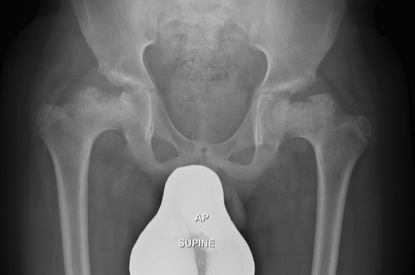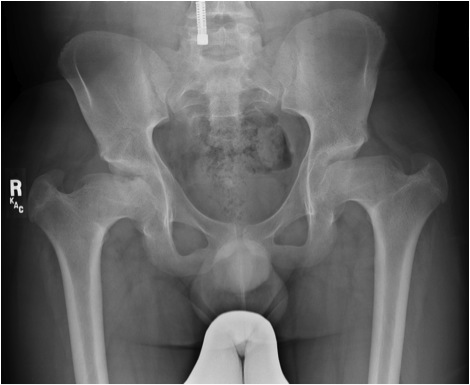Definition
Disturbance of endochrondral ossification of epiphyses of tubular bones
- preservation of vertebrae (c.f. SED)
Characteristics
Dysproportionate dwarfism with normal trunk
- not as severe as achondroplasia
- usually 145 - 170 cm tall
Characterised by small flattened irregular epiphyses
- symmetrical
- leads to OA by 3-4th decade
Types
Limb length may be affected, not as severe as achondroplasia (usually 145 - 170cm tall)
Spectrum of involvement
Ribbing
- mild form
- affect only the hips
Fairbank
- more severe
- affect the epiphyses of all long bones
Aetiology
AD
- variable expression
- affects collagen IX / COMP
Pathology
Disturbance of enchondral ossification in epiphysis & physis
- deficient proliferative region of physis
- rongue-like projections of cartilage into metaphysis
Radiology
Epiphyseal ossification
- delayed / smaller
- appear fragmented
- symmetrical involvement
Joint surfaces flattened & irregular
- Leads to premature osteoarthritis
Vertebral ring epiphysis maybe affected, only mildly
Clinical Feature
Varies in severity
- polyarticular or pauciarticular
- Some cases only couple of joints involved, others condition is widespread
Most commonly affects
- hips / knees / ankles / wrists
Spine, skull & face - normal
Mild shortness of stature
Normal intelligence
NHx
Present with stunted growth or joint pain and progressive deformity
- problems walking in childhood
Premature OA in adulthood
Hip
Most frequently & severely involved
- Coxa vara
- small irregular & fragmented capital epiphyses
- progressive flattening & extrusion of head
- poor head coverage


Premature OA common
Management
- valgus intertrochanteric osteotomy +/- shelf
DDx
1. Perthe's
- asymmetrical
- has metaphyseal cysts
- MED affects acetabulum
2. Cretinism
3. Pseudoachondroplasia
4. SED
Knee
Femoral condyles flattened & rectangular
Slanted tibial physis
Genu valgum common
Hands
Short stunted metacarpals
Digits shortened
